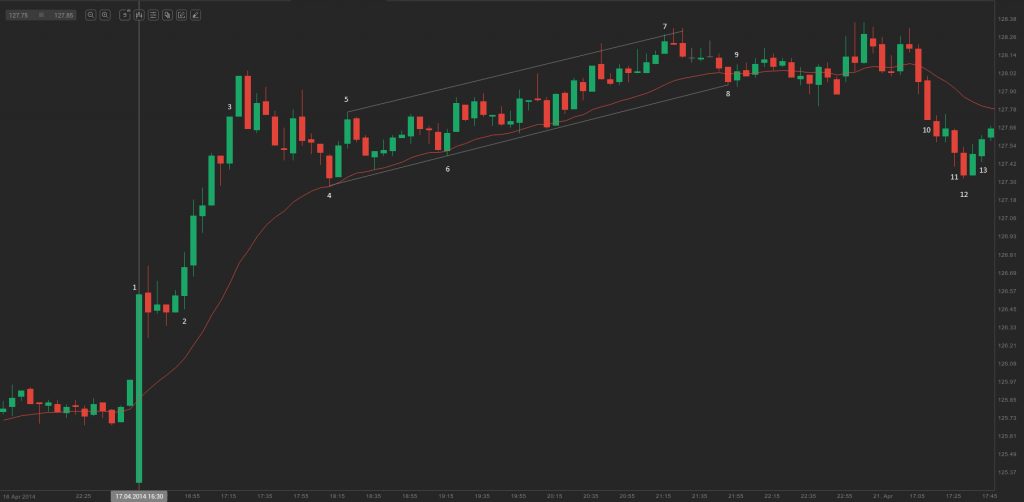Spike plus channel trends – illustrations part II
This lesson will cover the following
- A case including successive climaxes
- A case including a gap to the upside and a small double bottom formation
- A case including a spike and a climax
Successive climaxes
Successive climaxes represent another version of spike plus channel trends. As we already noted, every huge trend bar may be viewed as a breakout, a climax and a spike. On the 5-minute chart of Boeing Co. (BA) above bar 1 was a bullish spike, which ended with the bar 3 channel. The move to the upside to bar 3 was exceptionally steep, while bars from 1 to 3 could have been viewed together as one spike (they have probably created a spike when viewed on larger time frame charts).
Bars from 4 to 8 formed a bull channel. Bar 9 broke below the bull trend line. Bars 10 and 11 were successive sell climaxes, which finally led to the test of the starting point of the channel (this occurred at bar 12 low). These climaxes were followed by a pullback, as the high of bar 13 tested the high of the second climax bar.
A gap to the upside and a small double bottom formation
In case the market forms a huge gap up on the open of the trading day, it will usually be followed by a two-legged move sideways or to the downside before the start of the uptrend. In case the opening range, or the first five to ten bars, is below 30% of the average daily range, this means that the trading day is set to produce a breakout. Traders will look to buy a breakout to the upside and sell a breakout to the downside.
On the 5-minute chart of Boeing Co. (BA) above bar 1 was the end of a two-bar bull spike. The market then retraced sideways to bar 2. A series of bull trend bars marked the rally to bar 4, after which a bear spike appeared (bar 5). At this point, market players probably wondered whether a trend reversal would occur, because this bear spike was actually a reversal down from a higher high. This bear spike also followed a bull spike (bar 3). In case the market creates two strong spikes in the opposite directions within several bars of each other, then trading usually goes sideways, as bulls and bears struggle to form a channel. Bulls are willing to create a bull channel, while bears – a bear channel.
Within a trading range it is common to detect a bull spike and a bear spike, which is actually the phase when the market prepares for a breakout. The small doji bar X led to a two-bar bull spike (bar 3 and the bar following it), while the pullback, that could cause the formation of a bull channel, started with the bear spike (bar 5). The market was in a tight trading range, while buyers tried to begin their bull channel with bar 6 bull trend bar. However, it did not happen and the trading range continued.
A spike and a climax
On the 5-minute chart of AMZN above we are looking at another version of the spike plus channel trend – a spike plus climax, where the spike and the channel are actually reversed. There was a bull micro channel from bar 1 to bar 2, while bar 3 was a large bull trend bar. The micro channel actually had the function of a bull spike, while bar 3 had the function of a steep bull channel.


